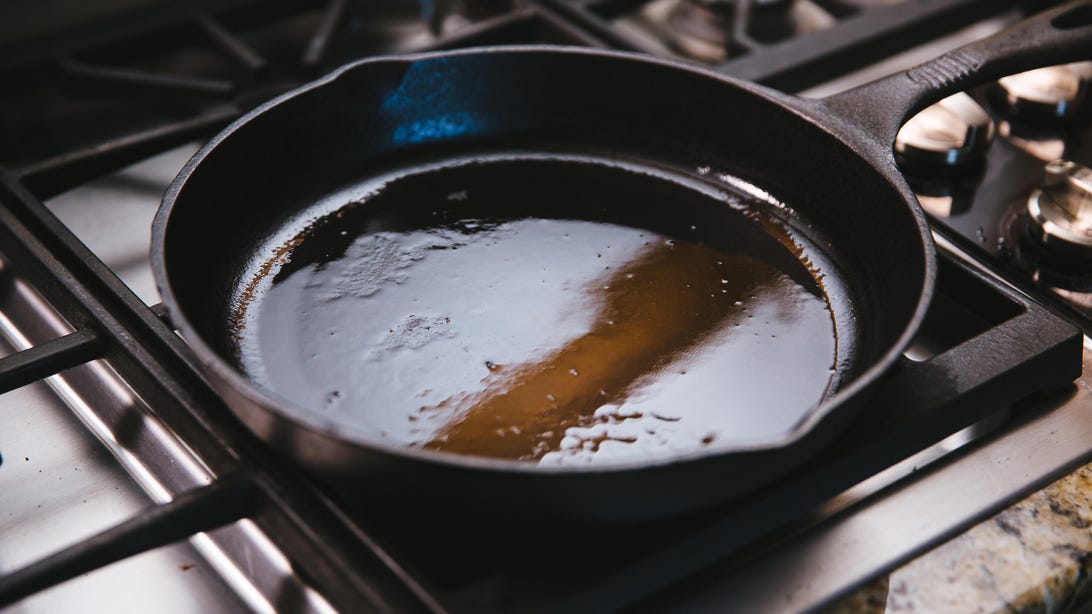
Cast iron takes a little more care to clean than some other materials, but it’s definitely worth it.
David Watsky/CNETCast iron is a favorite among home chefs, myself included. The tough-as-nails cookware is a fierce holder of heat, so it imparts more surface degrees than most other kinds of pan. It will also develop something of a natural nonstick coating, but that patina will never be completely nonstick, so you’ll often find some stuck-on bits of burger, pork chop, chicken and fish. Cast iron takes a bit more care to clean properly than some other cookware materials, but there are a few easy rules to follow to keep your cast iron clean and looking good without damaging the seasoning you worked so hard to create.
Here’s how to clean your cast-iron skillet with one secret-weapon ingredient that you almost definitely have on hand.
Read more: The 4 best frying pans for every type of cooking
Clean your cast iron while it’s still hot
Yes, I know, that sizzling steak is ready to eat and the last thing you want to do is clean the pan, but trust me, this will make the job easier. Add some warm water to the skillet immediately after removing it from the heat. That quick boil will do a lot of the work for you in degunking the pan later.


Clean your cast iron while it’s still hot.
David Watsky/CNETScrape with a wooden spoon or soft-bristle brush
With the hot water loosening the food from the pan’s surface, use a wooden spoon or soft brush to remove whatever’s left.
I like this $11 Oxo brush for cast iron. It works great on a classic flat skillet but has separated tufts of bristles so it’ll work really well on cast-iron grill pans or grates. If you prefer something more natural, a palm scrub brush like this one will work, but it might not last as long. You can employ a soft sponge but know that it’ll probably be the final act for that sponge.
Avoid using metal scrubbers that will damage the cast-iron surface. And beware of rubber and plastic spatulas, especially cheap ones, as they may melt against the hot metal.


This $11 Oxo brush is tough and especially good for cleaning between the grates of cast-iron grill pans.
David Watsky/CNETUse salt to clean cast iron when things are particularly stuck on
From a glance at your skillet, you should be able to tell what kind of a cleaning task you have on your hands. After most uses, a dousing of warm water should do the trick. But if things are extra-sticky, sprinkle the cast iron with bit of kosher salt (without water) and scrape it gently with a flat-ended wooden spoon or spatula. Dump the salt and add some water to get things moving.


A bit of kosher salt goes a long way in lifting stubborn bits of food.
David Watsky/CNETIf you need to scrub harder than you can with a wooden spoon or rag, use a brush of one of the types mentioned above.
Dry your cast iron immediately
Rusting is the most common problem folks face with cast iron, but it’s also one that is easily avoided. It’s important to dry your cast iron immediately and thoroughly. The best way is to use heat from the stovetop or oven, which will dry your skillet from the inside out, but you can also use a dry rag.
To dry a pan on the stove, just put it over low heat for a few minutes. You’ll see it release some steam and possibly some smoke too. When that starts to slow, your skillet is dry. Use medium heat to dry the pan in the oven if it’s still on. About 5 minutes at 325 F should be plenty.
Give it a quick reseasoning, why don’t cha?
After it’s dry and while it’s still hot, you can (and should) feel free to season it more with a cast-iron seasoning wax (I like Made In’s mix of beeswax, canola and flaxseed oil) or some other high-heat cooking oil. For more on that, check out this CNET guide to perfectly seasoning your cast-iron skillet
.


A quick seasoning after every few uses will keep your cast-iron skillet in great form.
Tyler Lizenby/CNETShould you use soap on cast-iron pans?
The No. 1 cast-iron cookware cleaning question is whether or not you can use soap to clean a skillet or grill pan. The answer is yes, but you should really try not to. A little bit of soap — I mean a real small dab — won’t ruin your cast iron, but certain harsh soaps will erode the nonstick patina and could also affect the flavor your cast iron has developed.

